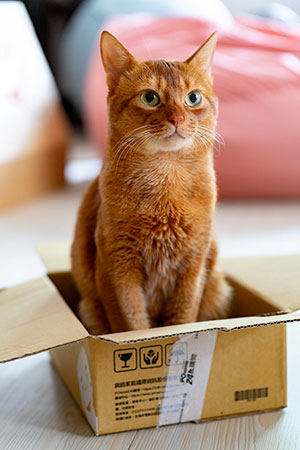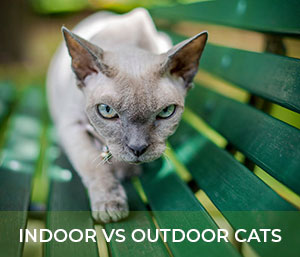How to be an eco-friendly cat owner and keep wildlife safe
We care about our planet and adore our cats, so with mounting evidence showing that pet food production and pet products are contributing to unhealthy ecosystems and climate change, it's important that we look at ways to minimise our impact.
In this article, we look at how to be an eco-friendly cat owner while also minimising threats to biodiversity.

5 easy ways to provide an eco and wildlife-friendly home for your cat
Cats are unique creatures; they offer enormous benefits to us, like social companionship, comfort, and emotional support. When it comes to our environment though, keeping a carnivore fed with a species-appropriate diet, and using traditional elimination substrates/litters is doing damage. Here are five eco-friendly cat care practices that will make a big difference as we all start to make better, cleaner choices.
1. Decrease fish in your cat's diet
There's a number of very good reasons to cut down on fish based cat food:
- Contrary to widespread belief, fish isn’t good for cats as they are obligate carnivores that have evolved to eat meat. Many felines are also allergic to fish products since fish contain elevated histamine levels.
- Some cats can become 'addicted' to fish and refuse to consume regular meals. Decreasing or removing fish products is excellent for the environment and can positively affect your cat’s health.
- Commercial cat food contains fish offcuts not fit for human consumption and is high in phosphorus and magnesium, which can lead to kidney and urinary tract disease in cats.
- Tuna and salmon may contain high levels of mercury, including pesticides and other toxins due to sea pollution, and should be avoided or fed only occasionally.
- Researchers have found a link between canned shellfish-based cat food and the development of hyperthyroidism in senior cats derived from consuming fish products exposed to PBDEs.
- Overfishing is one of the most significant reasons for declining marine wildlife populations, with one-third of all rays and sharks at risk of extinction due to overfishing. Pet food consumption makes up 10% of wild-caught fish.
2. Switch to biodegradable, natural cat litter products
Three things are inevitable when it comes to being a cat caregiver or breeder; there will be endless pee and poop to scoop from the litter box and the need for cat litter. But have you ever asked yourself what your cat litter is comprised of or how environmentally or cat safe it is?
Traditional cat litter is produced out of sodium bentonite clay and other minerals or synthetic silica gel, which are harmful to the environment due to the manufacturing and disposal process. Many cat litters also possess considerable amounts of silica dust linked to upper respiratory health issues in cats and humans.
Thanks to increased environmental and cat health concerns, there are greener options: Tofu Cat Litter Australia has to be one of the best biodegradable cat litters in Australia. It comprises 100% natural top-quality ingredients such as pea and soybean plant fibre, activated charcoal and baking soda.
Tofu Cat Litter Australia is the first enzyme-activated cat litter in the world which is fragrance and dust-free, suitable for fussy cats and owners. This eco-friendly litter is fast clumping and highly absorbent (4 times its dry weight in liquid) which means it lasts much longer and is better for the environment. It does an excellent job controlling urine and faecal odours whilst tracking and scattering are less noticeable around the house than other litter types. Buy yours now at Woolworths or Pet Stock. Rescues and cat breeders can access our special offer here.
3. Purchase cat toys that use sustainably grown materials, or make your own!
Play is essential for cats, especially for indoor-only felines, since it mimics hunting behaviour and releases happy endorphins in the cat’s brain. Look for cat toys made from natural plant materials like bamboo, cork, wood or hemp; alternatively, make your own from old clothes or sew needle-felted wool toys and stuff them with catnip.
4. Get creative and recycle household items
Recycle cardboard boxes for cats to sleep in or turn them into multi-level kitty condominiums to reduce environmental impact. Moreover, convert boxes into scent-stimulating foraging boxes by filling the carton with homemade treats hidden within multiple layers of reused paper.
Make homemade puzzle feeders with toilet rolls, ice cube trays and recycled drink bottles. Puzzle feeding stimulates your cat’s mind and provides physical exercise, helping to keep your cat fit and healthy.
Consider recycling or donating unused cat or household items to animal rescues and rehoming centres which they will be eternally grateful.
5. Change to eco-friendly cat products
An effortless way to reduce plastic is by switching to eco-friendly cat bowls like stainless steel and ceramic dishes. To ensure your cat is comfortable and warm, purchase sustainable wool or merino pet beds, including cat trees and accessories made from bamboo or other natural materials.
How to keep cats and wildlife safe
Most pet owners care about wildlife and want to prevent harm. The impacts that roaming has on individual cat health and wildlife is now well researched and understood, and keeping domestic cats indoors is a sure way to protect all species. Many jurisdictions are also developing and implementing laws around 'cat containment', some with heavy penalties and fines if cats aren't kept indoors. If your existing cat roams, gradually introduce them to being kept indoors at night, then progress to increasing the time they remain indoors during daylight hours. Cats can experience the outdoors and hunting thrill with minimal impact on wildlife with some imagination and the following gear:
Enrich your indoor cat's life with an enclosure, catio, or a catventure!
Create a safe outdoor space with Catnets. Cat netting provides secure cat containment designed to endure the harsh Australian weather while providing your cat with outdoor enrichment.
Suppose you are renting or unable to install netting in your backyard. A Catio (outdoor enclosure) or a portable cat enclosure is the best option that allows cats outdoor access while keeping them and wildlife safe. Furthermore, a cat enclosure can assist with behavioural issues while keeping your kitty blissful and healthy.
If your property lacks space or you can’t install a cat net or a Catio, train your cat to walk on a CatVenture harness and leash. Their eco-friendly leash is made from recycled plastic bottles decreasing pollution and promoting environmental conservation.
General tips to reduce our cats impact on wildlife
- Talk to cat loving friends, relatives and neighbours about the benefits of keeping their cats indoors at night-time as much as possible, especially male cats who tend to roam much further than females.
- Cats are crepuscular hunters which means they are most active at dawn and dusk when small mammals and birds are lively. Keep them contained at home during sunset and sunrise.
- Ideally, keep cats restricted indoors in springtime when many species are nesting and caring for their young.
- Place bird feeders at least four meters away from grass and bushes or hang bird feeders on a wire about three to four meters above ground in between several trees. Alternatively, replace bird feeders by planting native trees like Lilly Pilly, Lemon Myrtle and Bottlebrush to attract birds into your garden.
- Deter nesting areas or bird feeders with a solar-powered motion-activated sprinkler to protect wildlife and intrusion from stray cats. Sowing plants that repel cats, like rue, lemon-thyme or coleus, is also advantageous.
- Vaccinate your cat and conduct regular health checks to minimise disease transmission that can spread from felines to wildlife. Toxoplasmosis is a parasite that can infect humans and animals, leading to persistent illness and even death.
- Lastly, if you don’t want to keep your cat any longer, do the right thing and either rehome it or take it to an animal shelter. Please don't just 'let it go'.
Final thoughts
By working together, pet owners, animal advocates, pet businesses and conservationists can reduce our pet related environmental impacts and help protect all species, and our planet. To help promote eco and wildlife-friendly businesses and practices, Perfect Pets has recently partnered with Tofu Cat Litter Australia and Catnets to offer special deals and promotions. Contact us if you have an eco-friendly brand or business and would like to get involved in future initiatives.
References:
Life, W. W. (2021). Overfishing. Retrieved November 07, 2022, from World Wild Life
Marroquin, P. (2017, February 08). The truth about cats’ and dogs’ environmental impact. Retrieved November 05, 2022, from UCLA Institute of the Environment & Sustainability.
States, H. S. (2018). Cats, Wildlife and You. Washington, DC, USA. Retrieved November 02, 2022
WWF. (2021, June 30). Plastic waste and climate change - what's the connection Retrieved November 01, 2022, WWF-Australia.
Towards Understanding the Impacts of the Pet Food Industry on World Fish and Seafood Supplies - Scientific Figure on ResearchGate. Available from: [accessed 8 Nov, 2022]
Rochman CM, Lewison RL, Eriksen M, Allen H, Cook AM, Teh SJ. Polybrominated diphenyl ethers (PBDEs) in fish tissue may be an indicator of plastic contamination in marine habitats. Sci Total Environ. 2014 Apr 1;476-477:622-33. doi: 10.1016/j.scitotenv.2014.01.058. Epub 2014 Feb 3. PMID: 24496035.
The truth about cats’ and dogs’ environmental impact
Photo credits - Main photo - Cat in a box - Ethan Brooke, Cat in a box - Tim Volz

